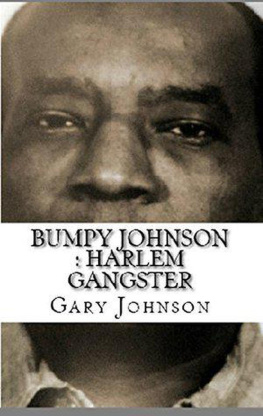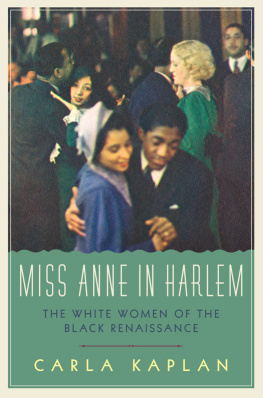
Marsha Darling, Series Editor
Rochelle Brock and Richard Greggory Johnson III
Executive Editors
Vol. 59
The Black Studies and Critical Thinking series is part of the Peter Lang
Education list.
Every volume is peer reviewed and meets
the highest quality standards for content and production.

SHIRLEY STEWART
THE WORLD OF
STEPHANIE
ST. CLAIR
AN ENTREPRENEUR, RACE WOMAN
AND OUTLAW IN EARLY TWENTIETH
CENTURY HARLEM

Library of Congress Cataloging-in-Publication Data
Stewart, Shirley (Shirley Pamela).
The world of Stephanie St. Clair: an entrepreneur, race woman and outlaw
in early twentieth century Harlem / Shirley Stewart.
pages cm. (Black studies and critical thinking; vol. 59)
Includes bibliographical references and index.
1. St. Clair, Stephanie, 18971969. 2. Caribbean Americans
New York (State)New YorkBiography. 3. Businesswomen
New York (State)New YorkBiography. 4. GangstersNew York (State)
New YorkBiography. 5. GamblingNew York (State) New YorkHistory
20th century. 6. Organized crimeNew York (State)New YorkHistory
20th century. 7. Harlem (New York, N.Y.)History20th century. I. Title.
F128.5.S72S74 974.7043092dc23 [B] 2013043241
ISBN 978-1-4331-2387-0 (hardcover)
ISBN 978-1-4331-2386-3 (paperback)
ISBN 978-1-4539-1272-0 (e-book)
ISSN 1947-5985
Bibliographic information published by Die Deutsche Nationalbibliothek.
Die Deutsche Nationalbibliothek lists this publication in the Deutsche
Nationalbibliografie; detailed bibliographic data are available
on the Internet at http://dnb.d-nb.de/.
Front cover photo: Stephanie St. Clair Hamid in Custody Bettmann/CORBIS
Back cover author photo: Courtesy of Simone V. Stewart. All rights reserved.
2014 Peter Lang Publishing, Inc., New York
29 Broadway, 18th floor, New York, NY 10006
www.peterlang.com
All rights reserved.
Reprint or reproduction, even partially, in all forms such as microfilm,
xerography, microfiche, microcard, and offset strictly prohibited.
About the author
SHIRLEY STEWART received a B.A. in political science and economics from Fordham University and an M.A. in womens history from Sarah Lawrence College. Her research and writing reflect an interest in women all over the world who agitate for positive change for their families and communities. Specifically, her work focuses on African women and women of African descent in the diaspora who have historically resisted negative social circumstances. She also writes on current womens issues, immigration issues, edits biographies and tutors adultsespecially immigrantsin basic literacy skills.
About the book
Born in Guadeloupe in 1897, Stephanie St. Clair entered the United States thirteen years later. By 1923 at the age of twenty-six she would create and manage a highly lucrative policy bank in Harlemearning a quarter of a million dollars a year. To this day, she remains the only black female gangster to run an operation of that size. Infamous gangster Dutch Schultz invited himself to share in the Harlem profits. Unlike other Harlem bankers, St. Clair resisted. Despite Schultzs threats, many of her male employees remained with her. Some said she paid them high wages and challenged them by asking, What kind of men would desert a lady in a fight?
Upon arrival in the United States St. Clair did not conduct her life in the manner expected of a black female Caribbean immigrant in the early twentieth century. What factors influenced St. Clairs decision to become an entrepreneur and activist within her community? Why did St. Clair describe herself as a lady when ladies did not run illegal businesses and they were not black? These questions are explored along with her lineagea lineage that contains the same fighting spirit that she carried throughout her life. This is not the story of a victim.
Courses concerned with the study of social and economic conditions of black urban residents during the early twentieth century and female entrepreneurs of the same era will find St. Clairs story compelling and informative.
This eBook can be cited
This edition of the eBook can be cited. To enable this we have marked the start and end of a page. In cases where a word straddles a page break, the marker is placed inside the word at exactly the same position as in the physical book. This means that occasionally a word might be bifurcated by this marker.
This work is dedicated to
Ida, Daisy, Daphne and Marjorie
The Grandmothers,
Simone
The Daughter,
And all the Caribbean women of my youth who made me stop and
think before I said or did something stupid. I didnt always listen
but I appreciated the effort.
Outlaw women are fascinatingnot always for their behavior, but because historically women are seen as naturally disruptive and their status is an illegal one from birth if it is not under the rule of men.
Foreword to Sula by Toni Morrison
x | xi
This book was nothing but a vague idea as I worked toward my masters and it would not have been possible without a few key individuals.
Priscilla Murolo questioned and challenged me on the subject until the idea became something of substance, something worthy of a thesis.
Gina Luria Walker gently guided me through the initial research and writing process. Whether it was a better word or phrase in a paragraph or offering words of wisdom, she always made the work sharper and more focused.
Katherine Butler Jones shared her knowledge of Stephanie St. Clair with me. Her recollections were much appreciated.
Marsha Darling worked with me to turn my thesis into a book. She was an unfailing champion of this project and led the way toward publication.
I am grateful for the professionalism of those at Peter Lang Publishing who brought this textvision intactto fruition.
Many thanks to the librarians and archivists at the Schomburg Center for Research in Black Culture, the New York Public Library, the New York State Archives, the Mount Vernon Public Library and the Esther Raushenbush Library at Sarah Lawrence College.
Finally, thanks to my daughter, Simone. She has been an unwavering source of encouragement and support. She also learned to eat dinner on the ten-inch square left on the dining room table that did not have a book on it. xi | xii
xii | 1
I n 1923, with $10,000 in seed money, Stephanie St. Clair launched and ran a highly-lucrative policy bank in Harlem that earned a quarter of a million dollars a year. To this day, she remains the only black female gangster to run a numbers racket of that size. The larger operations run by mobsters Dutch Schultz and Lucky Luciano actually saw a decline in earnings during the same years. Schultz, realizing the financial potential of numbers running in Harlem, invited himself to share in the proceeds of one of Harlems most lucrative businesses.
Unlike other Harlem policy bankers, St. Clair was not intimidated by Schultz. She declared on the front page of the New York Amsterdam News, Im not afraid of Dutch Schultz or of any other man living. Hell never touch me! One might speculate that she should have been afraidSchultz was a ruthless man. At the time, reports surfaced that Schultz tried to murder her on at least three occasions. St. Clair was strong and ruthless as well and his attempts to execute her only fueled her contempt for him. St. Clair expressed her disdain by physically destroying Schultzs base of operations and supplying information to government authorities. St. Clair made sure that Schultz knew she was the source of that information by discussing her activities with newspaper reporters.
Next page











